Serpukhovian
The Serpukhovian is in the ICS geologic timescale the uppermost stage or youngest age of the Mississippian, the lower subsystem of the Carboniferous. The Serpukhovian age lasted from 330.9 Ma to 323.2 Ma.[2] It is preceded by the Visean and is followed by the Bashkirian.
| System | Subsystem/ Series |
Stage | Age (Ma) | |
|---|---|---|---|---|
| Permian | Cisuralian | Asselian | younger | |
| Carboniferous | Pennsylvanian | Gzhelian | 298.9 | 303.7 |
| Kasimovian | 303.7 | 307.0 | ||
| Moscovian | 307.0 | 315.2 | ||
| Bashkirian | 315.2 | 323.2 | ||
| Mississippian | Serpukhovian | 323.2 | 330.9 | |
| Visean | 330.9 | 346.7 | ||
| Tournaisian | 346.7 | 358.9 | ||
| Devonian | Late | Famennian | older | |
| Subdivision of the Carboniferous system according to the ICS, as of 2017.[1] | ||||
The Serpukhovian correlates with the lower part of the Namurian stage of European stratigraphy and the middle and upper parts of the Chesterian stage of North American stratigraphy.
Name and definition
The Serpukhovian stage was proposed in 1890 by Russian stratigrapher Sergei Nikitin and was introduced in the official stratigraphy of European Russia in 1974.[3] It was named after the city of Serpukhov, near Moscow. The ICS later used the upper Russian subdivisions of the Carboniferous in its international geologic time scale.
The base of the Serpukhovian is at the first appearance of the conodont Lochriea crusiformis. In 2007, no GSSP had been assigned to the Serpukhovian stage yet. The top of the stage (the base of the Pennsylvanian subsystem and Bashkirian stage) is at the first appearance of the conodont Declinognathodus nodiliferus.[4] It is also slightly above the first appearance of the foram Globivalvulina bulloides, genozone of the ammonoid genus Homoceras and the ammonoid biozone of Isohomoceras subglobosum.[5]
Subdivision
The Serpukhovian stage includes four conodont biozones:
- Gnathodus postbilineatus Zone
- Gnathodus bollandensis Zone
- Lochriea cruciformis Zone
- Lochriea ziegleri Zone
In Russian stratigraphy, the Serpukhovian is subdivided into three substages, from bottom to top: Tarusian, Steshevian, and Protvian, named after places near Serpukhov (Tarusa and Protva). In British stratigraphy, the Serpukhovian (lower Namurian) contains three substages. These are from bottom to top: Pendleian, Arnsbergian and Chokierian (only the lower Chokierian falls in the Serpukhovian, the top falls in the Bashkirian).[6]
Serpukhovian life
Cartilaginous fishes
| Chondrichthyes of the Serpukhovian | ||||
|---|---|---|---|---|
| Taxa | Presence | Location | Description | Images |
| Belantsea | Mississippian | Montana, United States | A petalodontiform holocephalian | |
| Campodus | Carboniferous | Belgium | An eugeneodontid holocephalian | 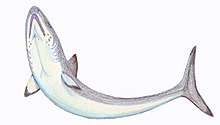 |
| Chomatodus | Mississippian | Illinois, United States | A petalodontiform holocephalian | |
| Diplodoselache | Mississippian | Scotland | A xenacanthiform elasmobranch | |
| Falcatus | Mississippian | Montana, United States | A symmoriidan holocephalian | 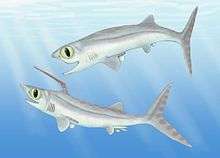 |
| Stethacanthus | Late Devonian to Carboniferous | Montana, United States; Scotland | A symmoriidan holocephalian | 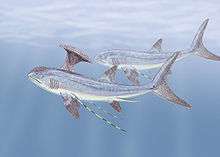 |
Coelacanths
| Actinistians of the Serpukhovian | ||||
|---|---|---|---|---|
| Taxa | Presence | Location | Description | Images |
| Caridosuctor | Arnsbergian | Fergus County, Montana | A basal actinistian of the family Rhabdodermatidae. | |
| Hadronector | Arnsbergian | Fergus County, Montana | A basal actinistian | |
| Lochmocercus | Arnsbergian | Fergus County, Montana | A close relative of the contemporary and sympatric Hadronector | |
| Polyosteorhynchus | Arnsbergian | Fergus County, Montana | A close relative of the contemporary and sympatric Hadronector | |
Tetrapodomorphs
| Tetrapodomorphs of the Serpukhovian | ||||
|---|---|---|---|---|
| Taxa | Presence | Location | Description | Images |
| Caerorhachis | Scotland | A genus of basal true tetrapod. Its placement within Tetrapoda is uncertain, |  | |
|
S. mirus: UK
S. pereger: Nova Scotia, Canada |
A genus of stem tetrapods in the group Baphetoidea | 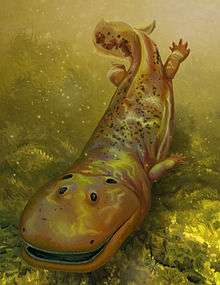 | |
Reptiliomorphs
| Reptiliomorphs of the Serpukhovian | ||||
|---|---|---|---|---|
| Taxa | Presence | Location | Description | Images |
| Eoherpeton |  | |||
| Proterogyrinus | 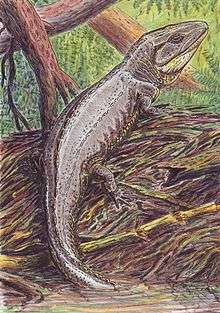 | |||
See also
References
- http://www.stratigraphy.org/index.php/ics-chart-timescale
- Gradstein, F.M.; Ogg, J.G. & Smith, A.G.; 2004: A Geologic Time Scale 2004, Cambridge University Press.
- Fedorowsky, J.; 2009: Early Bashkirian Rugosa (Anthozoa) from the Donets Basin, Ukraine. Part 1. Introductory considerations and the genus Rotiphyllum Hudson, 1942, Acta Geologica Polonica 59(1), pp. 1–37.
- Lane, H.R.; Brenckle, P.L.; Baesemann, J.F. & Richards, B.; 1999: The IUGS boundary in the middle of the Carboniferous: Arrow Canyon, Nevada, USA, Episodes 22(4), pp 272–283.
- Menning, M.; Alekseev, A.S.; Chuvashov, B.I.; Davydov, V.I.; Devuyst, F.-X.; Forke, H.C.; Grunt, T.A.; Hance, L.; Heckel, P.H.; Izokh, N.G.; Jin, Y.-G.; Jones, P.J.; Kotlyar, G.V.; Kozur, H.W.; Nemyrovska, T.I.; Schneider, J.W.; Wang, X.-D.; Weddige, K.; Weyer, D. & Work, D.M.; 2006: Global time scale and regional stratigraphic reference scales of Central and West Europe, East Europe, Tethys, South China, and North America as used in the Devonian–Carboniferous–Permian Correlation Chart 2003 (DCP 2003), Palaeogeography, Palaeoclimatology, Palaeoecology 240(1-2): pp 318–372.
- Heckel, P.H. & Clayton, G.; 2006: The Carboniferous system, use of the new official names for the subsystems, series and stages, Geologica Acta 4(3), pp 403–407.
Literature
- Nikitin, S.N.; 1890: Carboniferous deposits of the Moscow region and artesian waters near Moscow, Trudy Geologicheskogo Komiteta 5(5), pp. 1–182 (in Russian).
External links
- Carboniferous timescale at the website of the Norwegian network of offshore records of geology and stratigraphy
- Serpukhovian, Geowhen Database
- The Serpukhovian age, www.palaeos.com